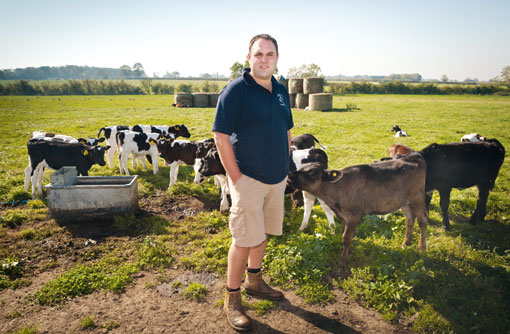Training heifers to graze grass

Grazing genetics plus excellent grassland management can produce cost-effective calf rearing that not only promotes rumen development, but hits heifer growth targets for two-year calving.
Growing heifers at grass also cuts concentrate inputs, reduces bedding and saves labour – with no check-in growth rates caused by a sudden turnout.
However, DairyCo extension officer Chris Coxon stresses that the key to success is offering quality leafy grass every day.
“A grazing-type heifer will have less to gain in terms of growth; calving at 90% of mature bodyweight of 500kg. But remember that a four-month-old heifer for instance, needs 40MJ/day to grow and she can only eat 3.5kg DM/day, so grass needs to be at least 11.5 MJME/kg DM,” he says.
Rumen development
Rumen development is stimulated by butyrate and propionate production from starchy feedstuffs. Mr Coxon points out that young, leafy spring grass is nature’s equivalent to a concentrate.
And producers who manage rotational grazing will be generating this leafy grass all year round. Following a good start on quality colostrum, milk-fed calves can be turned out to grass, although there are important timelines to consider.
“Getting rumen development started six weeks before planned weaning is important to ensure the calf doesn’t get a check when weaned. It takes three weeks of concentrate or fresh leafy grass intake to grow enough bacteria for the rumen to function and produce useful energy.”
Sufficient solids intake during milk feeding is therefore important, the aim being to double birth weights on milk. Six litres a head a day of 150g/litre milk powder under good temperatures can yield about 0.65kg/day of growth. When grass quality does fall, or it turns cold, supplementation or housing is essential.
“To achieve growth on grass alone, you have to be strict about when you move and the quality you offer. Consider extra feed such as concentrates, hay or silage, or housing/shelter to prevent dropping below target growth rates of 0.75kg/day,” he says.
Stocking rates
❚ Stocking rates are calculated as for mature cows: using heifer weights to judge desired DMI and measuring available grass in a paddock.
However, youngstock shouldn’t be put into heavy cow covers of 2,700kg DM/ha – it’s too daunting and won’t encourage high intakes. Instead, Mr Coxon suggests grazing at the two-leaf stage and, to avoid waste or poor re-growth due to slack grazing, operating a leader-follower system.
“Where stocking rates allow, grass at two leaves provides the acceptable quality and energy with less bulk. Grazing also has to be more lenient for calves with stock moving on every two to three days instead of daily to prevent back grazing. A system that provides four days’ feed for yearlings then two days’ feed for older stock is the absolute longest you can afford to stretch it.
“For instance, 250kg heifers need 6.25kg DM/day. A 0.5ha paddock with 2,500kg DM could therefore support 40 leaders for 500kg of growth over two days. Clear the residual with older heifers to get down to the desired 1,500kg DM/ha cover before too much re-growth is damaged and lost.”
Benchmark savings from rearing at grass include £30/calf for 120kg of starter concentrate, £8/calf of 0.1t straw bedding, while halving labour saves £12/calf adding up to £60/head in the first three months. “From weaning to 12 weeks, a further £7.50/calf saving in labour is possible,” adds Mr Coxon.
Case study: Tom Rawson, West Yorkshire
Major cost savings from straw bedding to drugs are possible when rearing calves at grass, according to dairy farmer Tom Rawson. “We get calves out in early April and that grass is good quality, so we can reduce concentrates,” he says.
Calving 240 cows this spring at the farm in Dewsbury, West Yorkshire, Mr Rawson expects about 100 calves, which will be run in three groups. Milk is fed via a 50-teat feeder and calves initially have access to the outdoors in a concrete yard before grazing five paddocks that are unsuitable for cows.
“We see that calves choose to be out. We have less pneumonia and there is also an element of training about it: as soon as we get heifers eating pasture the better. There is shelter from hedges and we graze rotationally. Ideally we would graze calves in front of cows across the farm, but we have too many boundaries.
“This year we’re also looking at regularly weighing calves using a weigh band as we hope to introduce this as one of our key performance indicators. At the moment, calves move up or down a group by eye. We’d like to make it more efficient.”
Training heifers to graze
- Save £30/calf concentrates
- Train heifers to graze behind electric fence
- Must provide 11.5 ME quality grass
- Promotes rumen development
- Use concentrates or housing in bad weather
